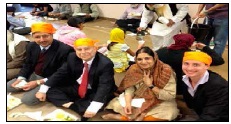Seeking Sikh-Muslim Peace
B y Dylan Kaplan
American University
Washington, DC

The large Sikh men with long white beards pounded the drums. Sikh men with red, blue, and orange colored turbans sat cross-legged in all corners of the sanctuary. Women dressed in bold blue, green, and purple Punjabi suits sat consumed in prayer. As I sat on the red carpet among the 300-400 guests in the audience with my hair covered in an orange cloth and my feet crossed I could not help but realize the significance of this moment as the Sikh prayers seemed to float towards heaven and consumed me. I had to constantly remind myself that I was not in a Sikh Gurdwara, the temple of worship for Sikhs, in a village in the Indian Punjab but in Rockville, Maryland.
Last Sunday, November 13th, I had the privilege of attending the most important Sikh holiday, honoring Guru Nanak, the revered founder of Sikhism. My mentor, Ambassador Akbar Ahmed, whom the BBC calls “the world’s leading authority on contemporary Islam,” was invited by the Sikh community to give the keynote address. This was the first time that a Muslim had ever been invited to speak at this very large Sikh temple. Ambassador Ahmed spoke about religious pluralism and tolerance and the need for Muslims and Sikhs to live at peace. The ambassador explained that through Guru Nanak’s life we “learn how he promoted the dialogue between the two great religions of India; Hinduism and Islam which added to the beauty and birth of Sikhism.” Ahmed quoted one of his favorite sayings of Guru Nanak: “When I give myself to thee O Lord, the whole world is mine.” He also spoke of the great Sufi Islamic saint Mian Mir, who, in an act of religious pluralism, was invited by Guru Arjan to lay the foundation stone at the Golden Temple, the Mecca of Sikhism.
Ahmed reminded us about the pain of partition when in 1947 India and Pakistan separated. He urged that the healing process begin. When Ambassador Ahmed finished, Dr Rajwant Singh, chairman of the Sikh Council on Religion and Education, said, “My heart was pounding with the power of his words” and that Ambassador Ahmed’s message was very important for the entire South Asian community. Later Manjula Kumar, a prominent Indian and a director at the Smithsonian Institute, wrote that Ahmed was “creating history … I have never had such a wonderful experience at any Gurdwara”.
In addition to Dr Singh we met White House representative Tuyet G. Duong. She spoke about the Obama administration’s desire to strengthen the relationship between the White House and the Sikh community. She told us about the similarities she found in her Buddhist faith to Sikhism. We also met Dr Nisar Chaudhury, the president of the Pakistan American league , who was visiting his first Gurdwara and was thrilled. We were also introduced to Sardar Harcharan Singh Brar, who is head of the Mian Mir Foundation in Amritsar. This is the equivalent of an Israeli Jew leading a foundation whose namesake is a Palestinian Muslim. I left the event feeling confident that if Muslims and Sikhs can be friends so can Muslims and Jews too.
As an American University college student and undergraduate senator I represent roughly 6,000 students in the American University student government. My university is a unique place where my constituency comprises of students of all backgrounds and faiths. I live in a community where I can have pro-Israel Jewish friends and Muslim Palestinian friends. However, to witness such a degree of commitment to religious pluralism as was shown at the Sikh temple was very moving. Interfaith dialogue is a challenging enterprise at this time of widespread Islamophobia, prejudice, and with a media that often increases misunderstanding between people.
The event at the Sikh temple exemplified the genius of Franklin, Jefferson, and Washington, the American founding fathers. The event showed American religious pluralism in live action. As a Jewish American college student from Bethesda, Maryland it was an unusual situation to be in a Sikh Gurdwara with a Pakistani Muslim, who was the former Ambassador from Pakistan to the United Kingdom. In how many countries can a Buddhist, Hindu, Jew, Muslim, and Sikh pray and eat peacefully together? How many countries in the world have a Sikh community that is so committed to bringing different people together that they would invite a Pakistani Muslim to speak on their most religious holiday? The founding fathers would have been pleased to see that their dream of a religiously pluralistic America is still of the utmost importance in their own country today. ( Dylan Kaplan is currently studying at American University and is a senator representing the undergraduate student body)

